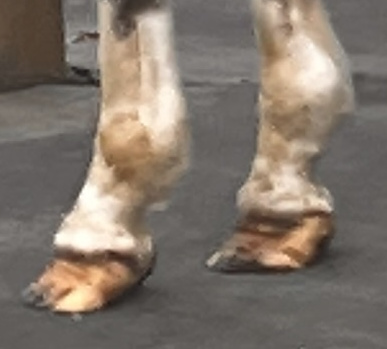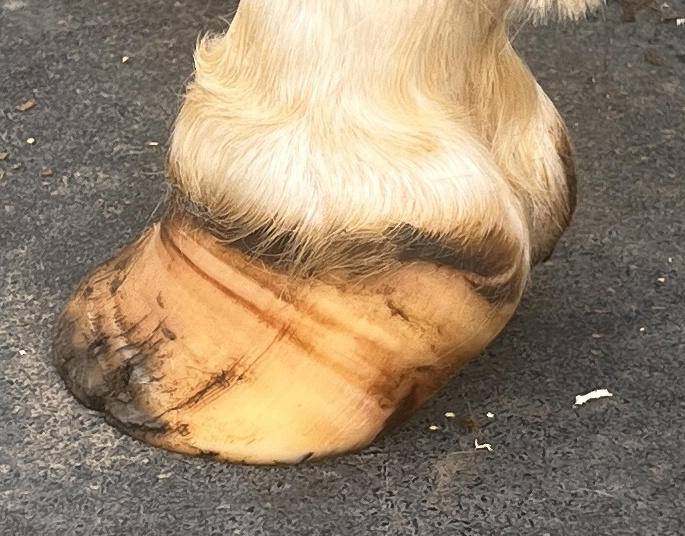no pain whatsoever he has the same demeanor same stance (even and erect) and full of energy. tries to sneak out of stall and mostly concerned w meeting all the other horses in new barn than anything
just posted pics from yesterday when I was cleaning his easy rides out and letting feet breathe for 20 mins like vet said to
Did you buy him from this trainer? Has trainer known the horse since birth? That’s a lot more problem than 3 cycles worth of trimming.
those feet haven’t been properly trimmed in a very long time.
The biggest tell-tale of clubiness is the more clubby the feet, the taller the heels WHILE the heel buttress stays at the back of the foot.
there may be some degree of uprightness here, but you can see also how far underrun the heel is, which means these feet are not all genetically this upright.
New farrier.
In this pic, it seems like there’s a genetic high-low going on - low LF, high RF. The RF tall heel is definitely farther back than the LF tall heel

New farrier.
I am so sorry that this is your first horse. What a stressful first experience. He certainly looks like a cutie, but I’ll be blunt: You were sold a horse that clearly had issues, and there will be some management challenges. On the bright side, you have a decent vet now, a better horse home, and what sounds like an honest, capable farrier.
I have to ask, though. Why weren’t xrays taken during the pre-purchase? Did you specifically say you did not want them? Or did the trainer/seller suggest they weren’t necessary?
Do not give up all hope.
The inflammatory issue of laminitis does not necessarily mean there is founder, i.e. rotation bad enough to render horse unrideable.
If, as you say, he’s moving normally & vet has not prescribed any pain med (bute, banamine) any rotation present can be dealt with.


 JINGLING the COTH Curbchain for you & your guy
JINGLING the COTH Curbchain for you & your guy
@Paint_Party I didn’t know X-rays were a thing tbh and I didn’t do as much research as I should have. I also blindly trusted and hired a professional @$1k mo.along w moving him to his barn where I had to pay dbl for his board. He said I would be able to be riding him within a month. nto someone else’s hands… this guy was actually under a rigorous 4-5 days a week program and was just clearing grids of 5 in a row, up to .70m high less than 3 weeks ago.
When the farrier told me how bad his feet were, trainer tried to discredit him and demanded that he continued his “training”. Saying how much it would set him back and basically warned he’d go back to square one w the time off. that’s when it hit me that he was only concerned about getting paid even if at the animals expense. I felt super pressure and that was the last thing I wanted to stress over so I moved him as soon as I could the next day.
I sent him a msg saying he prob has laminitis. He told me to get a second opinion…alas here I am.
As disappointing and depressing as him being lame… maybe forever, I can’t say I would’ve made a difference decision wbad x-rays.
I just certainly wouldn’t have put him through training if I had known. or anything that would cause more damage then apparently he already had.
is there anything I should ask or suggest to the new farrier when he comes today finally to shod what he can?
thank you so much for your help… It means a lot to me!
Please know you aren’t the first newbie horse owner who’s had someone take advantage of their naivete. Many of us have learned from our experiences over the years.
In general (there may be some real world exceptions), xrays are a standard part of a pre-purchase exam. At the very least, take images of the front feet. Even if the xrays are unremarkable, you have a baseline so if problems arise your vet can compare the new images to the originals to see what’s transpired.
As for what to suggest to the farrier: In these cases, I defer to the professionals.
But again, I’d have my vet draw blood on your cute horse to make sure there isn’t a metabolic component, or other health issue, that led to laminitis.
I did have blood taken and she said he is not metabolic … which is a breath of fresh air
If you are feeling overwhelmed, ask your vet to talk to your farrier. If you like these professionals, trust in them for now to develop a plan to help this horse. Ask questions and ask them to explain their plan and why. Ask them to explain how it’s going in subsequent appointments. That is the best way to learn.
Even for us experienced with horses, there will always be something that happens that will be a learning experience for us.
As your horse goes through changes with the feet there could be soreness at least in the body. It will take many months of good care to grow out new feet. It sounds like this horse is to be a jumper. I would hold off on that training entirely until the feet are doing a lot better. But movement in general is good for feet if you don’t have active low grade laminitis at this time.
If they are just bilateral club feet, they won’t look totally normal compared to another horse, but the goal will be to find what is appropriate for this horse. It is odd to have 2 club feet to this degree, and I agree with JB that one looks like more of a true club than the other. I suppose if he didn’t get appropriate movement as a foal this might have happened. But I would not rule out a past founder event yet. Maybe it was a mechanical founder, who knows, but the bloodwork and metabolic testing is a good idea.
The main thing to learn is how to manage this horse going forward. You are where you are and so there’s nothing to do but learn and try to do better for the horse, which you are already doing.
If your vet that did the X-rays didn’t do a whole horse exam, I would also do that at some point in the future after he’s out of the boots. If nothing else as said above, you have a starting baseline with this horse.
what they said 
One step at a time 
I am sorry that your professionals did not seem to help you the way a good professional should have.
I am actually surprised that a vet doing a PPE did not suggest that X-rays might be a good idea after seeing those feet. Were you actually there for the PPE?
More Jingles for your and your horse. It sounds like your new team has things handled.
I can imagine the way the conversation might have gone.
Vet: Are we looking at those front feet.
Trainer: They have never bothered him. I don’t think we need to spend client’s $$ on this
Client: Ok. I trust you, trainer.
What the vet may have wanted to do or may have suggested, if allowed a word in edge wise, may be very different to what actually happened.
My understanding is that the test for EMS throws some false negatives. Wouldn’t hurt to put him on an EMS diet just in case. I had a vet tell me that in his opinion all horses should be on it.
So much depends on what test was done, and how the horse was managed before the blood draw.
A horse needs to be “fasted” only in the sense that he’s been eating his normal hay/grass to the point of drawing blood. No concentrates.
The old method of a true fast - no food at all - does often result in false negatives.
Thanks. Interesting. Vet told us not to do test on my horse bc she would have put him on diet anyway given other signs—fat pockets, hangriness, etc—even if it had come back negative.
Noting that this was also the horse with the ouchy feet/NPA/etc.
The difference is that the metabolically healthy, but “efficient” horse (ie easy keeper) has some different management needs than the IR/EMS horse
You CAN treat the easy keeper as if he’s IR, but I sure wouldn’t want to deal with soaking hay, adding a few different supplements to support insulin sensitivity, etc, if I didn’t have to lol
My good friend purchased her dream horse through a trainer. Her farrier at the time recommended taking off the shoes when she came home and the ground was icy and bam - laminitis and 8 months off. Good news, she fired that farrier and got a new farrier who worked with her vet and they haven’t looked back since. That was maybe 5-6 years ago?
I also see many problems with the way the horses feet sere trimmed and managed. Like others have said, ditch that trimmer/farrier and bring in a good one who can work with your vet. Some very good farriers are a bit hesitant to work with vets so closely but would look at those feet and say “no”.
The trainer needs to be out of the picture.
What @IPEsq said. It will take many months to reshape those feet and they certainly can’t be fixed in one shoeing…and I suspect he might need shoeing, even if it’s not permanent. The nice thing is that if he’s sound, there’s so much low-impact riding you can do and groundwork to minimize pressure to the hoof. Not “fluff” riding, mentally engaging and physically work you can do that is rather low physiological impact on the hoof.
Good luck! A positive sign is that he has tolerated this bad hoof care quite well and isn’t a bucking bronc!

